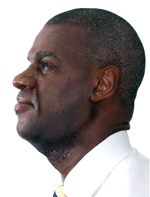Midcareer Malaise
Check out the related Live Online Chat featuring career advice.
Seventeen years into his career as a plaintiffs lawyer, Jeb Wait grew weary. He was tired of battling with the opposition, of court deadlines and of dealing with dishonest professionals.
For Wait it was something akin to a midlife crisis, and he decided to redirect his career into consulting for mass tort pharmaceutical litigation. The Houston lawyer, who also has a medical degree, says he is much happier after the shift.
“Midcareer,” he explains, “is when you wonder if what you’ve been doing was really what you wanted to do, while also wondering if you have enough time left to do something else that you really want to do.”
Call them the Jan Bradys of the legal profession—those lawyers in the middle. Typically, they’re 10 to 15 years out of law school and, if they’re practicing at law firms, are senior associates or junior partners.


Aminah Bhatti
Photo by Callie Lipkin
Aging by Joe Mullins
A lingering identity crisis can present itself when these attorneys hit the proverbial fork in the road. This is the point at which they are either going to make partner or make a change, the point at which they have a command of their subject matter but need to bring in more clients, the point at which—like Wait—they’ve become bored or weary and need to shake things up.
These midcareer crises are occurring earlier because the practice of law, particularly at large law firms, has changed. In the past, lawyers worked as associates for five or six years, made partner and then spent another 10 to 15 years practicing, according to Hindi Greenberg, a personal coach for lawyers.
“Then they played a lot of golf and took it easy,” adds Greenberg, founder of the Nevada City, Calif.-based Lawyers in Transition consulting service and author of The Lawyer’s Career Change Handbook. “Now if you’re going to make partner, it takes 10 years. And senior partners are expected to work as hard and bill as many hours and get as many clients as other partners, or the firm will ask you to leave.”
As a result, a senior associate up for partner or a newly minted junior partner is smack in midcareer.
“Look at the [law firm] attrition rate. Eighty percent [of lawyers] leave large firms by the fifth year,” adds Debra Bruce, a Houston-based attorney career coach.
“A lot of young lawyers are reconsidering options. It’s natural when you’re about 40 years old to start thinking [about making changes]; in law it happens a bit sooner because lawyers are not happy.”
In her practice advising attorneys, Bruce sees more and more junior partners complaining about business-development demands, prompting a re-examination of their previously unquestioned career paths.
Houston lawyer Bill Crook, for example, was eager to leave those business-development demands behind him—not to mention billable hours and the collections pressures of junior partnership. He made a midcareer switch from law firm partner to associate general counsel of a real estate investment trust.
“You may be a star associate before you make partner; but then you instantly become the lowest partner on the totem pole,” Crook says. That identity shift contributed to his decision to take the in-house opportunity. Though a midcareer job change did create some anxiety for Crook, he describes giving up the liabilities of law partnership as a “hallelujah moment” in his career.
DEFINING CHALLENGES
Hitting the junior partner level brings “a challenge to define yourself,” says Amy Van Zant, a partner in the intellectual property group at Heller Ehrman in Palo Alto, Calif. “There’s an identity crisis: figuring out all over again who you are and where you fit in. It takes time finding your own footing—just like when you’re a new associate, but there’s a lot less hand-holding. It’s up to you. It takes time to find your sea legs. But once you do, it’s exciting.”


Brian Thompson
Photo by Callie Lipkin
Aging by Joe Mullins
At big firms, being a midcareer lawyer means having more direct responsibility in working with clients, plus new administrative tasks—such as associate evaluations—that are unrelated to the practice of law, Van Zant says. So far she hasn’t felt pressure to suddenly become a big moneymaker for the firm.
“My role is to provide really excellent service to the clients we have,” she explains. “We [as midcareer lawyers] are the workhorses. We’re the direct connection to the associate team. I don’t feel undervalued.”
The midcareer lawyer has unique opportunities unavailable to younger attorneys. Tamara Pow, for example, spent her early years “learning and working on other lawyers’ clients.” But at midcareer she found herself a primary adviser to clients, and that expertise and seniority enabled her to leave large-firm life and establish her own firm, Structure Law Group, in San Jose, Calif. Unlike when she worked at the big firm, she now concentrates on her preferred specialty of real estate law and has a more flexible work schedule.
The move—eight years out of law school—was “an excellent midcareer report card,” Pow adds. “When I left the firm, I was not allowed to solicit clients. I simply announced a change of address. But almost all of my clients came with me. You don’t necessarily get a lot of feedback [on your practice] otherwise,” she says. “That kind of loyalty always makes you want to give them better and more personal service. It opened my eyes to how important relationships are with clients.”
One issue faced by anyone at midcareer, not just lawyers, is mounting boredom. “The first couple of years, it’s exciting to say, ‘I’m a lawyer.’ You carry a big briefcase and even the minutiae is new and exciting,” Greenberg says. “But then routine sets in.”
To combat that monotony and find renewed excitement, Greenberg recommends that midcareer lawyers find ways to do more of what they like doing, whether it’s making court appearances, writing or doing research. That may require volunteering with the local bar or a pro bono program, Greenberg says. Alternatively, lawyers should seek excitement in their free time. “Try skydiving,” she says.
Making it through the midcareer doldrums is largely about a person’s mindset, Greenberg adds.“It requires a change in attitude. The glass should be half-full. Law has a lot of tedium and repetition, a lot of crossing the T’s. But every business has tedium, so lawyers need to get over it.”
For her part, Van Zant says she has a positive view of the midcareer phase. “I haven’t hit that [boredom stage] yet. I saw the period as a trajectory of growth. I had new responsibilities. There’s nothing boring about it.”


Michael Hallock
Photo by Callie Lipkin
Aging by Joe Mullins
But many attorneys in the middle of their careers have a misguided, grass-is-greener impression of other jobs, according to Greenberg. “I hear a lot of, ‘Look at what so-and-so is doing,’ ” she says. “That’s the reality check I have to work on with my clients and disabuse them of the glamour of these things.”
For example, Greenberg cites the attorney who hates the stress and egos of law practice and the relentless editing by senior partners. Then that same lawyer proclaims he wants to be a screenwriter, which also involves stress, egos and getting edited. “Another lawyer tried being a chef, but found it too stressful so he went back to law,” Greenberg says. “He told me, ‘If you want stress, be a chef!’
“Other lawyers tell me they want to be agents. I explain that they’ll sit in their offices and write contracts. It’s not lunch with the stars.” For lawyers who think cooking, screenwriting and similar jobs are glamorous, Greenberg says, “I advise them to do it as an avocation.”
STAYING POSITIVE
David McAtee, an antitrust and securities litigator at the Dallas office of Haynes and Boone, gives talks to lawyers about staying creative and passionate midcareer.
“The practice of law—as distinguished from the profession of law—is cluttered with more mundane considerations of billing time, satisfying clients and juggling a seemingly endless array of obligations,” he explains, adding that many attorneys entered law school because they were idealistic about truth, fairness and justice. Slowing down and being solution-oriented rather than problem-oriented can help lawyers find satisfaction, he says.
In one program that McAtee gives on this topic, he encourages midcareer lawyers to strive to develop a calm confidence when people begin placing more demands on their time. “As stress builds, assure yourself that you will be able to handle the additional work with the expertise and attention to detail required of a lawyer at your level or, alternatively, you will be able to shift priorities, communicate with colleagues and enlist the help of other people to handle the project in that manner.”
McAtee similarly recommends that lawyers continually examine and adjust their approach to work. “I watch lawyers I respect and I consider whether any of their habits, no matter how small, would improve my performance.”
According to McAtee, studying the most successful lawyers of this generation reveals a common thread: They love what they do for a living. “They are happy being a lawyer or at least happier than they would be in some other profession. And you get the sense that their professional life, as demanding as it is, enriches their personal life in a way that makes sense to them. You can tell that they have chosen how they want to practice law, and their choice suits them well.”
Attorney coach Bruce adds that the lawyers who “get detached from their values, from the reasons why they wanted to be a lawyer,” are the unhappy ones. She recommends that midcareer attorneys get back in touch with why they wanted to practice law in the first place. “They need to keep the meaning in it so that even the mundane tasks are tolerable.” This sort of midcareer analysis can be assisted by a coach or a counselor, even a spiritual leader, she says.
Similarly, getting an assessment from an organization like the Johnson O’Connor Research Foundation, which helps people identify their aptitudes, can also assist in refining goals midcareer. Learning about your abilities is important, Bruce says, because “if you’re not using natural talents, you will be dissatisfied.” For example, “lawyers are wordsmiths, but there are not a lot of opportunities for creative writing” in the law, which is why “you will always find at least one lawyer” in continuing education writing classes.
A critical step in career satisfaction is getting in touch with what brings you peace, what Bruce calls “those things that you’d get lost in doing,” and figuring out what they have in common. “I’m not a great artist, but just sitting down and painting with watercolors relieves stress. And it’s the opposite of what lawyers do,” she explains. Also, taking care of yourself physically and emotionally helps prevent midcareer burnout.
Some lawyers in the middle may also be rejuvenated by switching practice areas or finding a new perspective on the same practice, according to Bruce. “Family lawyers are now being trained in collaborative law because the practice was so hostile, it was tearing families apart—and that didn’t comport with the lawyers’ values,” she says. “The negativity of the practice causes burnout.”
Lawyers facing this should look for ways to practice differently so that their practice lines up with their values, such as looking for mutually beneficial solutions rather than simply seeking to beat the other side. Keeping the same practice but moving to a different kind of firm may also help.
“The sheer hours of associates at big firms may be too much,” Bruce says. “They can do the same practice but go to a smaller firm” where the billable-hours requirement is reduced.
The good news is that switching jobs may actually be easier for midcareer lawyers than any other attorney demographic, Bruce says. Because of the attrition rate, attorneys with more than five years of experience and real skills are in high demand. “It takes about three years for associates to be profitable for firms. They really want those senior associates, the workhorses with whom they don’t have to share a piece of the pie,” she explains. Greenberg cautions, though, that midcareer moves to large firms may require that the attorney have a sizable book of business or an in-demand specialty.
‘KEEP THE GRINDERS HAPPY’
For their part, big firms are making an effort to keep midcareer lawyers happy. “Generation Y and women want a life balance,” Bruce explains. “The 50-year-olds don’t understand that, but they’re in a bind because there are not enough bodies to do the work. It’s forcing law firms to think in different ways. There’s no longer a stigma about choosing a different path, such as opting to become an income partner instead of an equity partner.”
Some firms will offer permanent associate or of-counsel positions to these workhorses, according to Greenberg. Though these lawyers might not be bringing in their own new clients, midcareer lawyers do make monetary sense for many large firms. “In this industry, we say there are ‘finders, minders and grinders’ at law firms. Firms need to keep the grinders happy.”
San Jose firm owner Pow similarly sees firms trying to find a place for associates who are never going to make partner. “It brings a lot of value to be a good associate who doesn’t want to make partner,” she says. “Law firms need a good workhorse and not everyone can be out selling.”
Christine LaFollette, partner in charge of the Houston office of Akin Gump Strauss Hauer & Feld and a member of the firm’s management and partnership admission committees, says senior associates are the lifeblood of her firm. The firm has a vested interest in helping them to seamlessly transition to junior partner without a midcareer crisis. “We make an investment in their careers through training and mentoring,” she says. “We want them to become integral parts of teams. They wouldn’t have reached this stage if they didn’t have skills.”
Akin Gump relies on offsite retreats to both woo and groom midcareer attorneys. In addition to formal sessions detailing the firm’s strategy, the retreats provide team-building opportunities such as having lawyers work together to build bikes for underprivileged kids. “We pull everyone out of the office environment, which helps them feel like they’re part of something,” she says. “It takes an investment to know your colleagues or partners. That’s hard to see as a young attorney because you’re so busy building a skill set.”
Indeed, many newer attorneys are shortsighted about their careers, according to Wait. Planning ahead for some of the challenges they will face as midlevel lawyers should be on every new lawyer’s to-do list. “Many junior lawyers too often try to determine where they can make the most money in the shortest time,” he says.
THE VALUE OF FORESIGHT
Greenberg advises that new lawyers “be a little bit more selective” about picking a first job out of law school. “Don’t just take the first job thrown at you,” she says. “Instead, think about your career path. Focus more. Look out 10 to 15 years and ask yourself what you want to be doing. Do you need expertise so you can open your own practice? Do you want to go in-house? Then do transactional work. Do you want to be at a smaller or a bigger firm?”
Having a mentor early on helped Akin Gump’s LaFollette maneuver through the midcareer phase. “He took me under his wing,” she says about her mentor. “We talked about law and the nonlaw [parts of our lives]. He helped me keep balance in my work, and he was very influential in my keeping the passion for law practice.”
Van Zant similarly recommends that new lawyers network with senior attorneys at their own firms, “including offering to assist on client pitches.” Structure Law Group’s Pow adds that at large firms, partners are the real clients of junior associates. As a result, “there are political connections you need to be working on.”
The biggest career mistake that Bruce sees is new lawyers who are so worried about billing a certain number of hours that they put their heads down and don’t maintain relationships. “When you’re a junior lawyer, your cohorts don’t yet decide who gets the business,” she says, “but they will.”
Younger lawyers should get to know accountants, auditors, law school classmates and people on the other side of deals. “They may be referral sources down the road. Even if the CFO won’t give you the time of day, build relationships with people who may be reporting to the CFO,” says Pow. “Those people will appreciate your attention and they will be CFOs someday.”
Similarly, Pow adds, if junior associates hope to one day open their own shops, they “need to become a big part of the community” before the midcareer stage.
This kind of foresight takes time and energy, but it’s worth it, experts say. Midcareer “quickly changes to end of career,” Wait cautions. As a result, he advises, “don’t hesitate to make the choice to make a change. There are a limited number of years to enjoy what one does professionally, and very few are fortunate enough to truly enjoy what they do for a lifetime.”
INSIDE OUR PHOTO SHOOT
The models pictured in this story are young Chicago lawyers—and good sports. They were photographed by Callie Lipkin. Their images were digitally aged to show how they might appear 10 (hard) years from now, in the midst of a midcareer malaise. The digital aging was done by Joe Mullins, who handles the sobering task of aging photos of children who disappeared years earlier for the National Center for Missing and Exploited Children.
The lawyers and their ages today, in the order in which they appear: Cover—Kelly Peterson, 30; Aminah Bhatti, 25; Brian Thompson, 29; and Michael Hallock, 25.
Leslie A. Gordon, a former lawyer, is a legal journalist based in San Francisco.



